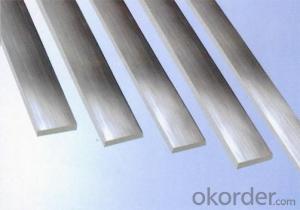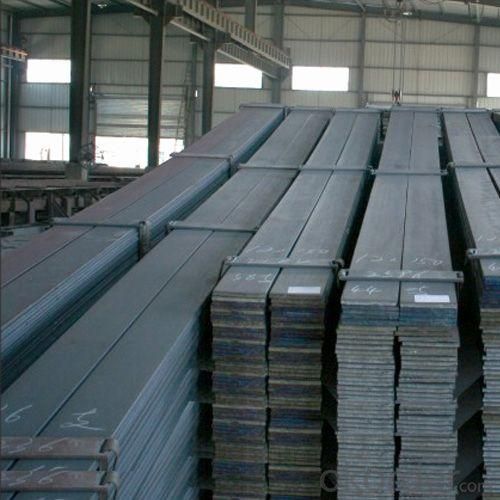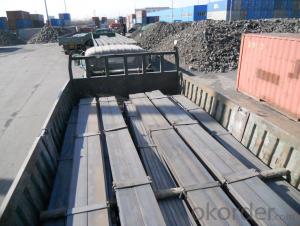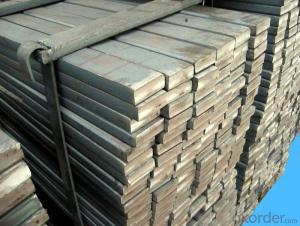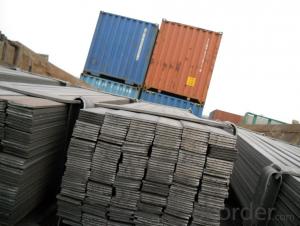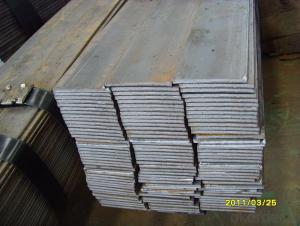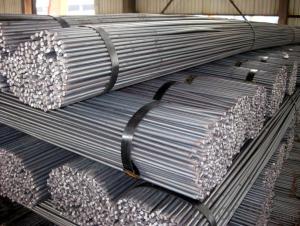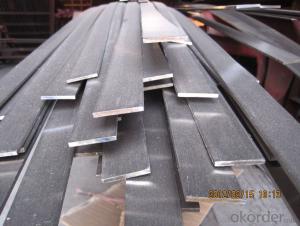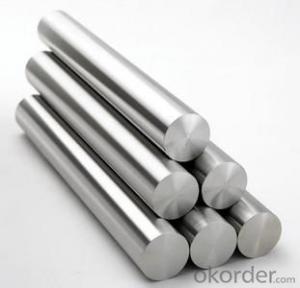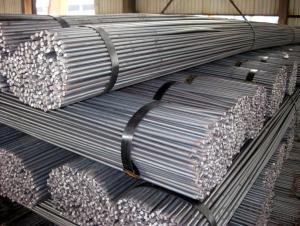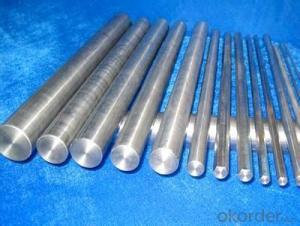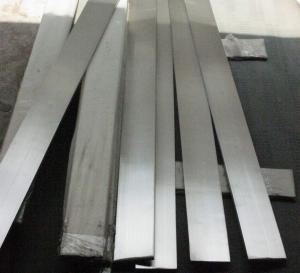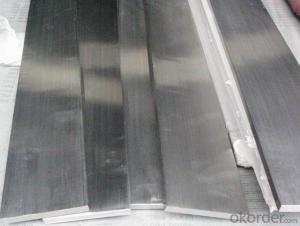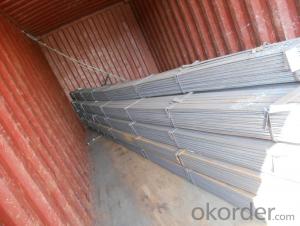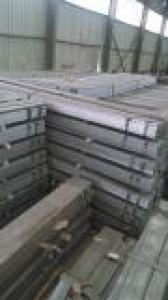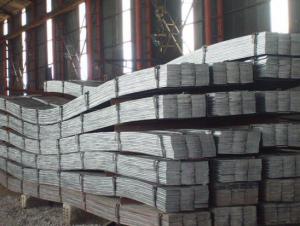Wide Flat Bar Q235 High Quality 3MM-30MM Hot Rolled
- Loading Port:
- Shanghai
- Payment Terms:
- TT or LC
- Min Order Qty:
- 25 m.t.
- Supply Capability:
- 10000 m.t./month
OKorder Service Pledge
OKorder Financial Service
You Might Also Like
Product Applications:
Q235 High Quality Wide Flat Bar 3MM-30MM Hot Rolledare ideal for structural applications and are widely used in the construction of buildings and bridges, and the manufacturing, petrochemical, and transportation industries.
Product Advantages:
Q235 High Quality Wide Flat Bar 3MM-30MM Hot Rolled are durable, strong, and resist corrosion.
Main Product Features:
· Premium quality
· Prompt delivery & seaworthy packing (30 days after receiving deposit)
· Corrosion resistance
· Can be recycled and reused
· Mill test certification
· Professional Service
· Competitive pricing
Product Specifications:
Manufacture: Hot rolled
Grade: Q195 – 235
Certificates: ISO, SGS, BV, CIQ
Length: 6m – 12m, as per customer request
Packaging: Export packing, nude packing, bundled
Commodity: Mild Steel Flat Bar Standard: GB;JIS Material: Q195-235;SS400 Brand name: FLATSPACE Origin place: China Thickness: 3mm-30mm Width:20mm-200mm Length: Max 12m Certification: SGS/BV Chemical composition of Q235
Physical properties of Q235
| ||||||||||||||||||||||||||||||||||||||||||||||||||||||||||||||||||||||||||
FAQ:
Q1: Why buy Materials & Equipment from OKorder.com?
A1: All products offered byOKorder.com are carefully selected from China's most reliable manufacturing enterprises. Through its ISO certifications, OKorder.com adheres to the highest standards and a commitment to supply chain safety and customer satisfaction.
Q2: How do we guarantee the quality of our products?
A2: We have established an advanced quality management system which conducts strict quality tests at every step, from raw materials to the final product. At the same time, we provide extensive follow-up service assurances as required.
Q3: How soon can we receive the product after purchase?
A3: Within three days of placing an order, we will begin production. The specific shipping date is dependent upon international and government factors, but is typically 7 to 10 workdays.
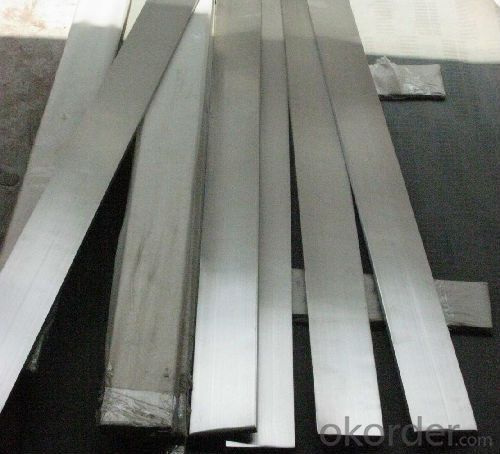
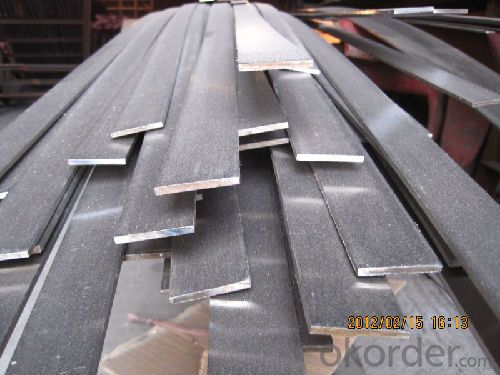
- Q: How do steel flat bars perform in terms of weather resistance?
- Steel flat bars are renowned for their exceptional ability to withstand various weather conditions. Typically manufactured from high-quality steel alloys, these bars have been specifically engineered to endure harsh environmental elements. To enhance their weather resistance, the steel used in flat bars is often coated or treated with protective layers, such as galvanization or powder coating. The corrosion, rust, and degradation that can be caused by moisture, humidity, rain, and snow are effectively combated by steel flat bars. This feature makes them particularly suitable for outdoor applications or regions prone to extreme weather conditions. When compared to materials like wood or aluminum, steel flat bars are more durable and less susceptible to damage resulting from exposure to the elements. Moreover, steel flat bars exhibit resistance to UV radiation emitted by the sun. Unlike other materials, they do not fade, discolor, or degrade when exposed to sunlight. Consequently, these bars are ideal for outdoor structures, including fences, handrails, and grating, as they maintain their appearance and structural integrity over an extended period. It is crucial to acknowledge that the weather resistance of steel flat bars depends on the specific grade of steel utilized and the protective coatings applied. Additionally, regular maintenance, such as cleaning and the application of protective coatings, can further enhance their longevity and weather resistance.
- Q: The steel, steel and flat steel, round steel bar and what is the difference?
- In fact, for the processing of raw materials are the same, is used when the roller rolling pressure is not the same, there are many different types of tooth roller shaft, can produce different steel, the steel section is square, round cross section is round...
- Q: Can steel flat bars be welded?
- Yes, steel flat bars can be welded. Welding is a common and widely used method for joining or repairing steel materials, including flat bars. The process involves heating the steel to its melting point and then fusing the two pieces together using a welding electrode or filler material. The resulting weld creates a strong and durable bond, making it suitable for various applications in construction, manufacturing, and other industries where steel flat bars are commonly used. However, it is important to follow proper welding procedures and techniques to ensure a successful and structurally sound weld.
- Q: How do you remove burrs or sharp edges from steel flat bars?
- There are several methods available for removing burrs or sharp edges from steel flat bars: 1. Grinding: Utilizing a grinding wheel or belt sander is a commonly used technique. Simply hold the steel flat bar firmly and glide it along the grinding wheel or belt sander, applying moderate pressure. Move the bar back and forth, ensuring all edges are evenly ground until the burrs or sharp edges are eliminated. 2. Deburring tools: Various handheld deburring tools specially designed for eliminating burrs and sharp edges from metal surfaces can be found on the market. These tools typically have a handle with a replaceable blade or cutting bit. Securely hold the steel flat bar and run the deburring tool along the edges to shave off the burrs. 3. File: Another effective tool for removing burrs from steel flat bars is a metal file. Choose a file with a fine or medium tooth pattern, depending on the severity of the burrs. Hold the file at an angle to the steel bar and apply even pressure while moving it back and forth along the edges. Continue filing until the burrs are smoothed out. 4. Sandpaper: If the burrs are not too severe, sandpaper can also be used. Begin with a coarse-grit sandpaper and gradually progress to finer grits until the burrs are no longer present. Wrap the sandpaper around a wooden block or use your hand to sand the edges evenly. Always remember to wear protective gloves and eyewear when working with metal to avoid injury. Additionally, it is crucial to securely fasten the steel flat bar before attempting any of the aforementioned methods to ensure stability and prevent accidents.
- Q: What are the load capacities of steel flat bars?
- The load capacities of steel flat bars vary depending on various factors such as the dimensions (width, thickness, and length) of the bar, the type of steel used, and the specific application it is being used for. Steel flat bars are known for their high strength and durability, making them capable of supporting significant loads. However, it is important to consider the specific requirements and constraints of the application in order to determine the appropriate load capacity. Load capacities for steel flat bars can be calculated using engineering formulas and standards. These calculations take into account factors such as the maximum stress the bar can withstand without deformation or failure, the support conditions (e.g., whether the bar is fully supported or simply supported at both ends), and the distribution of the load along the length of the bar. It is advisable to consult engineering handbooks, codes, or professional engineers to accurately determine the load capacity of a specific steel flat bar for a particular application. They can provide the necessary calculations and guidance based on the specific requirements, ensuring that the load capacity is not exceeded and that the safety of the structure or component is maintained.
- Q: What are the applications of steel flat bars in the automotive industry?
- Steel flat bars are extensively utilized in the automotive industry due to their wide range of applications and numerous benefits. Some of the primary uses of steel flat bars in the automotive sector include: 1. Chassis and Frame Components: Automobiles often incorporate steel flat bars in the construction of chassis and frame components. These bars offer the necessary strength and rigidity to support the vehicle's weight and endure various forces and vibrations. 2. Suspension Systems: Suspension systems, including leaf springs and torsion bars, are fabricated using steel flat bars. These components assist in absorbing shocks and vibrations, thereby enhancing the overall ride quality and stability of the vehicle. 3. Braking Systems: Steel flat bars are integral to the construction of various braking system components, such as brake shoes and brake rotors. They provide the essential strength and durability to withstand the high temperatures and pressures associated with braking. 4. Safety Features: Steel flat bars find application in the manufacturing of safety features like roll bars and roll cages. These components offer additional protection to the vehicle's occupants in the event of a rollover or collision, thereby improving overall safety. 5. Bumpers and Grilles: Automobile bumpers and grilles are often fabricated using steel flat bars. These bars provide impact resistance and safeguard the engine and other vital components located at the front and rear ends of the vehicle. 6. Body Panels: Steel flat bars are extensively used in the construction of body panels, such as door frames, roof rails, and window frames. Their strength and stability contribute to maintaining the structural integrity of the vehicle's body. 7. Exhaust Systems: The manufacturing of exhaust systems, including exhaust pipes and mufflers, incorporates steel flat bars. These bars offer high-temperature resistance, corrosion resistance, and durability, ensuring efficient exhaust gas flow and reducing noise levels. In conclusion, steel flat bars play a vital role in the automotive industry by providing strength, durability, and reliability to various components and systems. They significantly contribute to the overall performance, safety, and longevity of automobiles.
- Q: Can steel flat bars be used for making storage cabinets?
- Indeed, storage cabinets can be crafted from steel flat bars. These bars possess robustness and longevity, rendering them ideal for constructing cabinets capable of enduring substantial weights. Their exceptional structural integrity permits effortless welding or bolting to achieve a stable and secure storage solution. Moreover, steel flat bars exhibit resistance to rust and corrosion, guaranteeing the cabinets' longevity. Therefore, employing steel flat bars in the creation of storage cabinets is a pragmatic decision that yields strength, durability, and an air of professionalism.
- Q: How do steel flat bars contribute to the overall efficiency of industrial structures?
- Steel flat bars contribute to the overall efficiency of industrial structures in several ways. First and foremost, their durability and strength make them an ideal choice for structural components. Steel flat bars are known for their high tensile strength, which means they can withstand heavy loads and provide structural stability. This strength allows for the construction of taller and more complex industrial structures that can house various equipment and machinery. Furthermore, steel flat bars are highly versatile and can be easily fabricated, cut, and welded to fit specific design requirements. This flexibility enables engineers and architects to create customized industrial structures that maximize space utilization and optimize workflow. Whether used as support beams, braces, or reinforcements, steel flat bars can be tailored to meet the specific needs of a project, reducing construction time and costs. In addition, steel flat bars are resistant to corrosion and can withstand extreme weather conditions, making them suitable for both indoor and outdoor industrial structures. This resistance ensures longevity and reduces the need for frequent maintenance, saving both time and money in the long run. Moreover, steel flat bars are readily available and cost-effective compared to other materials. Their widespread availability and standardized sizes make procurement and construction processes more efficient, resulting in shorter lead times. This accessibility also allows for easy repairs and modifications, ensuring that industrial structures can adapt to changing needs and technologies without significant disruptions. Overall, steel flat bars contribute to the efficiency of industrial structures by providing strength, versatility, durability, and cost-effectiveness. Their usage enhances the structural integrity of buildings, optimizes space utilization, reduces maintenance requirements, and allows for easy customization. As a result, steel flat bars play a crucial role in the construction of efficient and reliable industrial structures.
- Q: How do steel flat bars compare to granite flat bars?
- Steel flat bars and granite flat bars have several differences that should be considered when comparing them. Firstly, steel flat bars are made from a durable and strong material, which makes them highly resistant to bending and breaking. Granite, on the other hand, is a natural stone that is known for its strength and durability. However, it is not as strong as steel and may crack or chip under heavy loads or impacts. Secondly, steel flat bars are more versatile in terms of their applications. They can be easily cut, welded, and shaped to fit specific requirements. Steel flat bars are commonly used in construction, manufacturing, and fabrication industries due to their malleability. Granite flat bars, on the other hand, are primarily used in the construction and design of countertops, flooring, and other architectural elements. Another important factor to consider is the aesthetic appeal. Steel flat bars have a sleek and industrial look, which makes them suitable for contemporary designs. Granite flat bars, on the other hand, have a natural and timeless beauty. They are available in various colors and patterns, making them a popular choice for adding elegance and sophistication to interior and exterior spaces. In terms of maintenance, steel flat bars require regular cleaning and occasional rust prevention measures to maintain their appearance and prevent corrosion. Granite flat bars, on the other hand, are relatively low maintenance. They are naturally resistant to stains, scratches, and heat, making them easy to clean and maintain. Lastly, the cost is an important consideration. Steel flat bars are generally more affordable than granite flat bars. While the price of granite varies depending on the quality and availability, it is generally more expensive than steel due to its natural sourcing and fabrication process. In summary, steel flat bars and granite flat bars have different strengths and weaknesses. Steel offers durability, versatility, and affordability, making it suitable for various applications. Granite, on the other hand, provides natural beauty, strength, and low maintenance, making it an excellent choice for adding elegance to architectural designs. Ultimately, the choice between steel and granite flat bars depends on the specific requirements, budget, and desired aesthetic of the project.
- Q: Are steel flat bars used in the manufacturing of agricultural machinery?
- Steel flat bars are frequently employed in the production of agricultural machinery. These flat bars find extensive use in structural elements, like frames, supports, and brackets, owing to their exceptional strength and durability. They confer stability and rigidity to the machinery, guaranteeing its ability to endure substantial loads and challenging operating conditions. Furthermore, steel flat bars possess excellent weldability, rendering them a versatile option for connecting various parts of agricultural machinery. In conclusion, the incorporation of steel flat bars in the manufacturing process of agricultural machinery serves to augment the performance, lifespan, and dependability of these machines in the agricultural sector.
Send your message to us
Wide Flat Bar Q235 High Quality 3MM-30MM Hot Rolled
- Loading Port:
- Shanghai
- Payment Terms:
- TT or LC
- Min Order Qty:
- 25 m.t.
- Supply Capability:
- 10000 m.t./month
OKorder Service Pledge
OKorder Financial Service
Similar products
Hot products
Hot Searches
Related keywords
